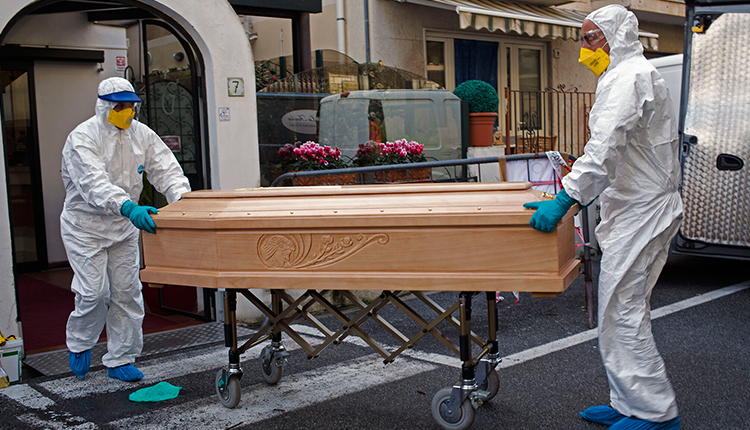WHO: Dead bodies of coronavirus victims ‘not infectious’ if handled properly
Dead bodies of coronavirus victims are generally not infectious, said the World Health Organisation (WHO) said in a recent report.
“Except in cases of hemorrhagic fevers (such as Ebola, Marburg) and cholera, dead bodies are generally not infectious.” WHO said in its interim guidance on Infection Prevention and Control for Safe Management of a Dead Body in the Context of COVID-19, released on April 10.
“Only the lungs of patients with pandemic influenza, if handled improperly during an autopsy, can be infectious. Otherwise, cadavers do not transmit disease.”
WHO said the virus is transmitted between people through respiratory droplets when an infected person coughs, sneezes, or speaks, adding: “It is not airborne.”
“Based on current evidence, the COVID-19 virus is transmitted between people through droplets, fomites, and close contact, with possible spread through faeces. It is not airborne.”
Except in cases of hemorrhagic fevers (such as Ebola, Marburg) and cholera, dead bodies are generally not infectious.https://t.co/vGfu3p0tX3 #COVID19 #coronavirus pic.twitter.com/7i63gOBKvL
— World Health Organization (WHO) (@WHO) April 10, 2020
Below are some of WHO’s key considerations for the safe management of a dead body in the context of COVID-19
- The safety and well-being of everyone who tends to bodies should be the first priority. Before attending to a body, people should ensure that the necessary hand hygiene and personal protective equipment (PPE) supplies are available;
- The dignity of the dead, their cultural and religious traditions, and their families should be respected and protected throughout;
- Hasty disposal of a dead from COVID-19 should be avoided;
- Ensure that personnel who interact with the body (healthcare or mortuary staff, or the burial team) apply standard precautions, including hand hygiene before and after interaction with the body, and the environment; and use appropriate PPE according to the level of interaction with the body, including a gown and gloves.
- If there is a risk of splashes from the body fluids or secretions, personnel should use facial protection, including the use of face shield or goggles and medical mask;
- Prepare the body for transfer including removal of all lines, catheters and other tubes;
- Ensure that any body fluids leaking from orifices are contained;
- Keep both the movement and handling of the body to a minimum;
- Wrap body in cloth and transfer it as soon as possible to the mortuary area;
- There is no need to disinfect the body before transfer to the mortuary area;
- Body bags are not necessary, although they may be used for other reasons (e.g. excessive body fluid leakage);
- No special transport equipment or vehicle is required;
- Healthcare workers or mortuary staff preparing the body (e.g. washing the body, tidying hair, trimming nails, or shaving) should wear appropriate PPE according to standard precautions (gloves, impermeable disposable gown [or disposable gown with impermeable apron], medical mask, eye protection);
- If the family wishes only to view the body and not touch it, they may do so, using standard precautions at all times including hand hygiene.
- Give the family clear instructions not to touch or kiss the body;
- Embalming is not recommended to avoid excessive manipulation of the body;
- Adults above 60 years and immunosuppressed persons should not directly interact with the body;
For autopsy – if needed, WHO says:
- Safety procedures for deceased persons infected with COVID-19 should be consistent with those used for any autopsies of people who have died from an acute respiratory illness;
- If a person died during the infectious period of COVID-19, the lungs and other organs may still contain live virus, and additional respiratory protection is needed during aerosol-generating procedures (e.g. procedures that generate small-particle aerosols, such as the use of power saws or washing of intestines);
- Perform autopsies in an adequately ventilated room, i.e. at least natural ventilation with at least 160L/s/patient air flow or negative pressure rooms with at least 12 air changes per hour (ACH) and controlled direction of air flow when using mechanical ventilation;
- Only a minimum number of staff should be involved in the autopsy;
- Appropriate PPE must be available, including a scrub suit, long sleeved fluid-resistant gown, gloves (either two pairs or one pair autopsy gloves), and face shield (preferably) or goggles, and boots. A particulate respirator (N95 mask or FFP2 or FFP3 or its equivalent) should be used in the case of aerosol-generating procedures.
For burial process, WHO recommends the following:
- Family and friends may view the body after it has been prepared for burial, in accordance with customs. They should not touch or kiss the body and should wash hands thoroughly with soap and water after the viewing;
- Those tasked with placing the body in the grave, on the funeral pyre, etc., should wear gloves and wash hands with soap and water after removal of the gloves once the burial is complete.



